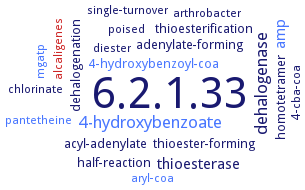6.2.1.33: 4-chlorobenzoate-CoA ligase
This is an abbreviated version!
For detailed information about 4-chlorobenzoate-CoA ligase, go to the full flat file.

Word Map on EC 6.2.1.33 
-
6.2.1.33
-
dehalogenase
-
4-hydroxybenzoate
-
thioesterase
-
amp
-
half-reaction
-
thioester-forming
-
adenylate-forming
-
thioesterification
-
acyl-adenylate
-
4-hydroxybenzoyl-coa
-
homotetramer
-
dehalogenation
-
4-cba-coa
-
single-turnover
-
pantetheine
-
aryl-coa
-
alcaligenes
-
diester
-
chlorinate
-
mgatp
-
poised
-
arthrobacter
- 6.2.1.33
-
dehalogenase
- 4-hydroxybenzoate
-
thioesterase
- amp
-
half-reaction
-
thioester-forming
-
adenylate-forming
-
thioesterification
-
acyl-adenylate
- 4-hydroxybenzoyl-coa
-
homotetramer
-
dehalogenation
-
4-cba-coa
-
single-turnover
- pantetheine
- aryl-coa
- alcaligenes
-
diester
-
chlorinate
- mgatp
-
poised
-
arthrobacter
Reaction
Synonyms
4-CB:CoA ligase, 4-CBA:CoA ligase, 4-chlorobenzoate:CoA ligase, 4-Chlorobenzoate:coenzyme A ligase, 4-Chlorobenzoyl-CoA ligase, 4-Chlorobenzoyl-coenzyme A ligase, 4-Halobenzoate-coenzyme A ligase, CBAL, CBL, chlorobenzoate:CoA ligase, Synthetase, 4-chlorobenzoyl coenzyme A
ECTree
Advanced search results
Crystallization
Crystallization on EC 6.2.1.33 - 4-chlorobenzoate-CoA ligase
Please wait a moment until all data is loaded. This message will disappear when all data is loaded.
hanging drop vapor diffusion method, 1.0 and 2.2 A. Crystal structures of the enzyme both in the unliganded state and bound to 4-chlorobenzoate. The space group is P3(1)21 or P3(2)21 with a = b = 129.3 A, c = 71.5 A
-
purified recombinant CBL bound to 4-chlorobenzoyl-AMP, hanging drop vapor diffusion at 4°C using 16-24% pentaerythritol propoxylate 426, and 0.1 M K+-HEPES, pH 6.5 or 6.75, and optimized via hanging drop vapor diffusion using 14-18% PEG 1000, 50-100 mM magnesium nitrate and 100 mM MOPS, pH 7.0, the cryoprotectant contains 24% pentaerythritol propoxylate 426, 24% ethylene glycol, and 0.1 M K+-HEPES, 1 mM ATP, and 1 mM 4-chlorobenzoate, X-ray diffraction structure determination and analysis at 2.0-2.25 A resolution, molecular replacement
purified recombinant enzyme, X-ray diffraction structure determination and analysis, modelling
mutant D402P, to 2.6 A resolution, and comparison with wild-type. The C-terminal domain rotates by about 140 degrees between the two states that catalyze the adenylation and thioester-forming half-reactions. The domain rotation is accompanied by a change in the main chain torsional angles of residue D402


 results (
results ( results (
results ( top
top





